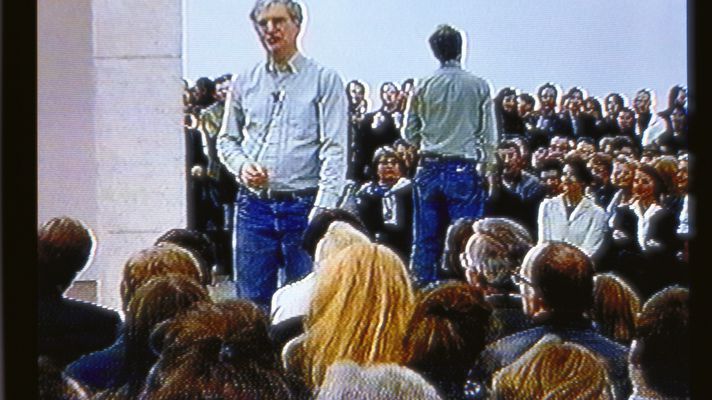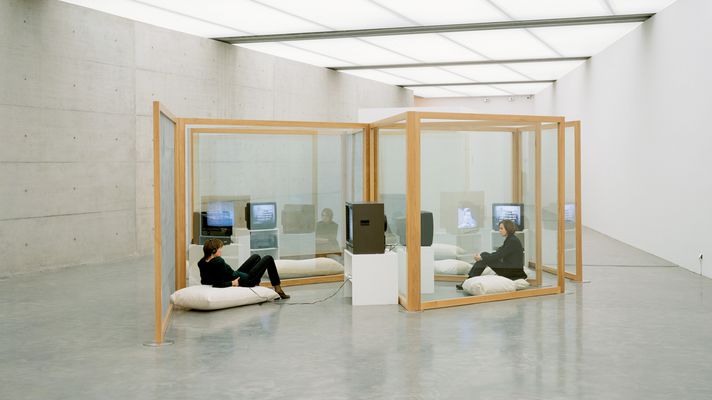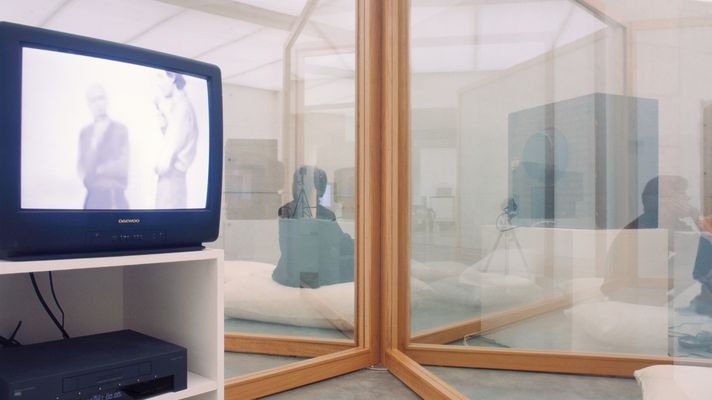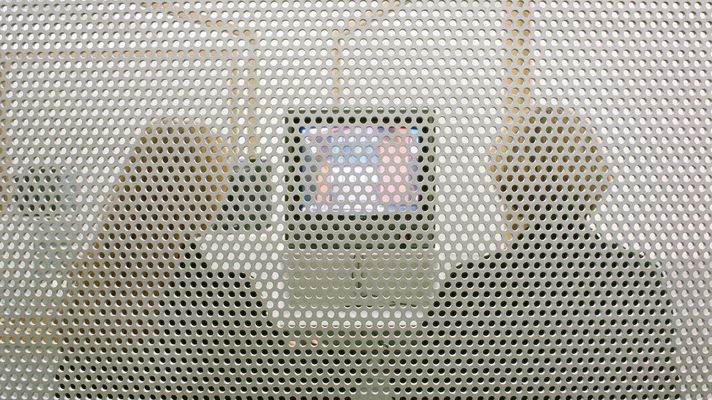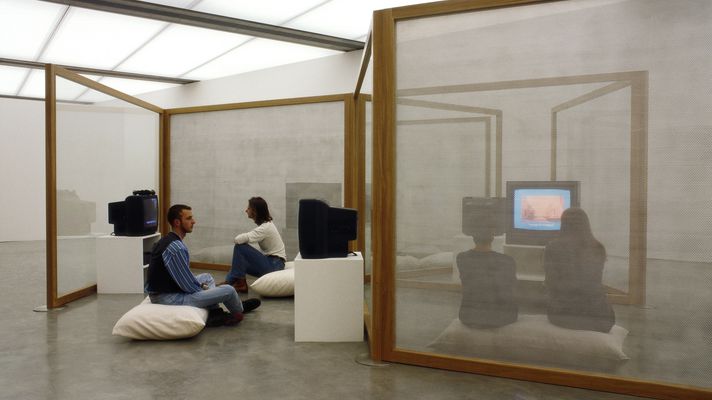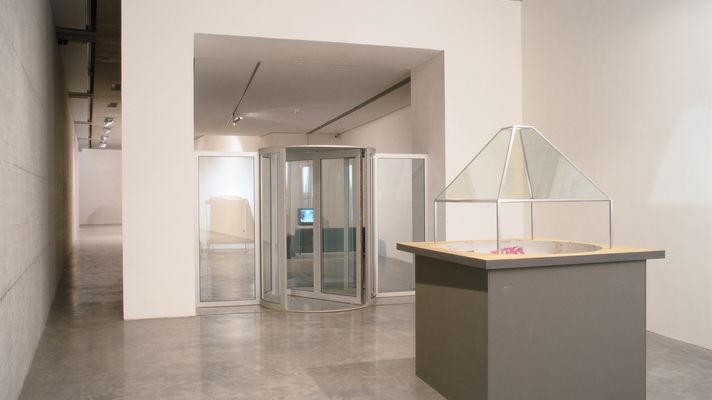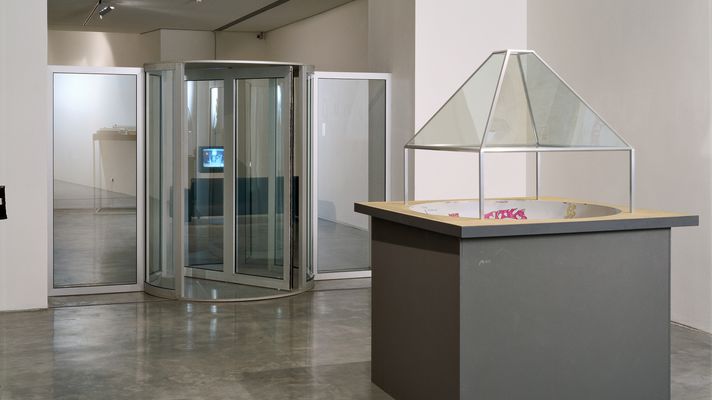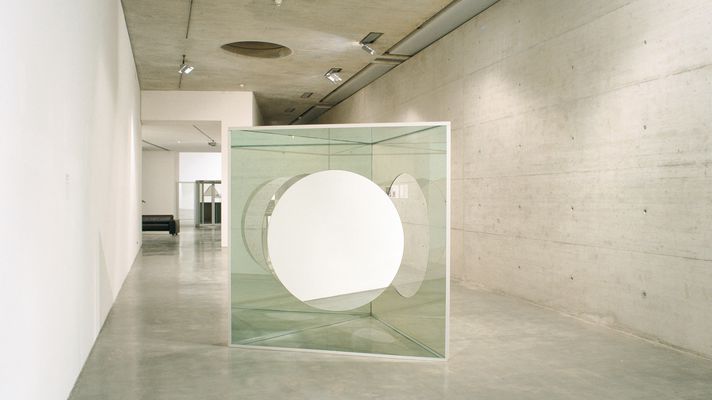Dan Graham
Video/Architecture/Performance
Exhibition opening: 4 October 1995, 7 p.m.
5 October through 17 December 1995
Place of exhibition: Generali Foundation, Wiedner Hauptstraße, 1040 Vienna
Dan Graham conceived a major work for the Generali Foundation, which was produced for this exhibition. This installation has meanwhile become a central work in the collection and has been shown at further exhibitions such as Documenta X. "New Space for Showing Videos" is based on a previous work from the mid-eighties with indoor and outdoor identities ("Three linked Cubes/Interior Design for Space Showing Videos"). This work, a functional sculpture/pavilion, has a dual identity.
Placed outside, it is an opened pavilion illuminated by the sun; placed indoors, it is transformed into Interior Design for Space Showing Videos. Here, various video monitors and speakers are placed in such a way to allow three separate programs for audiences subdivided into six groups. The effects of the changing illumination from the video images reflected on the glass panels create the mirror "ghosts" of audience members seen in other enclosed bays on the divider. The work is both a functional exhibition design and an optical artwork, displaying both the video images and the spectators' reactions to the video-viewing process in the social space of the video exhibition situation (Dan Graham speaking about "Three Linked Cubes/Interior Design for Space Showing Videos").
"New Design for Showing Videos" uses punched aluminum (two aluminum sheets with small holes). The small holes refer to the small pixels on the video image. They are semi-transparent when seen from a short distance and completely transparent when the viewer’s eye is pressed directly to an opening. This relates to the transparency and shifting semi-reflection/transparency of the two-way mirror panels, a shift caused by changes in the projected video images. The spectators’ images of themselves and others observing the videos and each other and their own gazes and "other spectators’" gazes are the content of the intersubjective philosophical aspect of the structure.
"New Design for Showing Videos" belongs to a series of open-sided double triangular pavilions. None of these pavilions has been completed to date. Here the artist was working for the first time with punched aluminum along with glass (transparent glass, 2-way mirror). The program features Dan Graham's most important videos which are shown alternately, on even and uneven dates.
The exhibition presents the first major showing of Dan Graham's works in Austria. The survey includes video installations, works on architecture, and models of projects in public space.
"Opposing Mirror and Monitors on Time Delay" (1974) is being shown for the first time in Austria. "Yesterday/Today" (1975) from the "Time-Delay" series is installed as well. The exhibition also presents the video installation "Two Viewing Rooms" (1975).From the artist's pieces on architecture, shown will be "Revolving Doors for Loie Fuller" (1987) and "Triangle with Circular Inserts" (1991).
The following models are also part of the show: "Alteration to a Suburban House" (1978), "2-Way Mirror and Hedge Labyrinth" (1989), "Children’s Pavilions" (together with Jeff Wall, 1989), "Museum for Gordon Matta-Clark" (together with Marie Paul McDonald, 1984), as well as "Skateboard Pavilion" (1989), and "Star of David" (1989). The two latter pieces are taken from our collection.
A selection of Dan Graham’s conceptual works is accessible via documentation.
Another highlight is the artist's performance "Performer/Audience/Mirror" on the opening night (first performed in 1977). In this performance, he stands facing the audience and a mirror is behind him in which both he and the audience are reflected. In four steps he describes for five minutes, without interruption, what he notices about the movements and positioning of the audience and/or himself and arrives at psychological conclusions. In doing that, he is first turned directly to the audience and later, to the mirror whereas the audience, at all times, sees what he is describing, mirrored. This gives rise to a multiple interaction between describer and observers, that which is described and the behavior of those observed.
As the manager of a New York gallery, Dan Graham (born in 1942, Urbana, U.S., lives and works in New York), organized the first exhibition of artists recognized today as the most important protagonists of Minimal Art. He has also become known as an author of texts on art, architecture, and rock music. After the closing of the gallery, he began his own work as an artist.
Curator: Sabine Breitwieser
Exhibition Coordination: Ursula Graf
